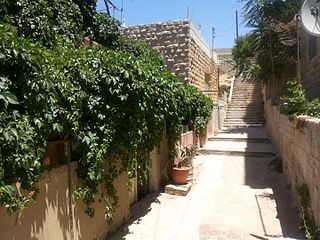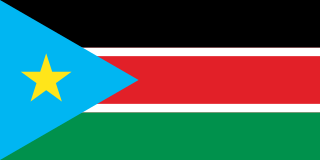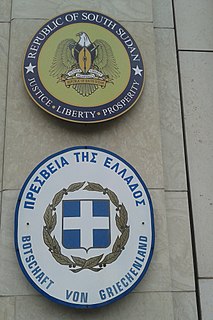
Khartoum or Khartum is the capital of Sudan. With a population of 5,274,321, its metropolitan area is the largest in Sudan. It is located at the confluence of the White Nile, flowing north from Lake Victoria, and the Blue Nile, flowing west from Lake Tana in Ethiopia. The place where the two Niles meet is known as al-Mogran or al-Muqran. From there, the Nile continues north towards Egypt and the Mediterranean Sea.

Sudan, officially the Republic of the Sudan, is a country in Northeast Africa. It borders the countries of Central African Republic, Chad, Egypt, Eritrea, Ethiopia, Libya, South Sudan, and the Red Sea. It has a population of 44.91 million people as of 2021 and occupies 1,886,068 square kilometres, making it Africa's third-largest country by area, and the third-largest by area in the Arab League. It was the largest country by area in Africa and the Arab League until the secession of South Sudan in 2011, since which both titles have been held by Algeria. Its capital is Khartoum and its most populated city is Omdurman.

The demographics of Sudan include the Sudanese people and their characteristics, Sudan, including population density, ethnicity, education level, health, economic status, religious affiliations, and other aspects of the population.

Arab Americans are American citizens of Arab heritage. Arab Americans trace ancestry to any of the various waves of immigrants of the countries comprising the Arab World.

The rich and varied music of Sudan has traditional, rural, Northeast African roots, and also shows Arabic, Western or other African influences, especially on the popular urban music from the early 20th century onwards. Since the establishment of big cities like Khartoum as melting pots for people of diverse backgrounds, their cultural heritage and tastes have shaped numerous forms of modern popular music. In the globalized world of today, the creation and consumption of music through satellite TV or on the Internet is a driving force for cultural change in Sudan, popular with local audiences as well as with Sudanese living abroad.
The Fur are an ethnic group predominantly inhabiting western Sudan. They are concentrated in the Darfur region, where they are the largest ethnic group. They speak the Fur language, which belongs to the Nilo-Saharan family.
"Misirlou" is a folk song from the Eastern Mediterranean region, with origins in the Ottoman Empire. The original author of the song is not known, but Arabic, Greek and Jewish musicians were playing it by the 1920s. The earliest known recording of the song is a 1927 Greek rebetiko/tsifteteli composition influenced by Middle Eastern music. There are also Arabic belly dancing, Armenian, Persian, Indian and Turkish versions of the song. This song was popular from the 1920s onwards in the Arab American, Armenian American and Greek American communities who settled in the United States.
The Kuku are a tribe of the Karo people from South Sudan. They inhabit the agricultural lands of Kajokeji County in Central Equatoria State. The Kuku speak a Bari dialect, also called Kuku.

The Lost Boys of Sudan refers to a group of over 20,000 boys of the Nuer and Dinka ethnic groups who were displaced or orphaned during the Second Sudanese Civil War (1987–2005). Two million were killed and others were severely affected by the conflict. The term was used by healthcare workers in the refugee camps and may have been derived from the children's story of Peter Pan. The term also was used to refer to children who fled the post-independence violence in South Sudan in 2011–2013.
Armenians in the Middle East are mostly concentrated in Iran, Lebanon, Cyprus, Syria, Jordan and Jerusalem, although well-established communities exist in Iraq, Egypt, Turkey and other countries of the area including, of course, Armenia itself. They tend to speak the western dialect of the Armenian language and the majority are adherents of the Armenian Apostolic Church, with smaller Catholic and Protestant minorities. There is a sizable Armenian population in the thousands in Israel. There is also the Armenian Quarter in Jerusalem with a history that goes back 2,000 years. Armenians in Lebanon have the most freedoms, compared to other regions in the area that have large number of Armenians.
The Armenians in Syria are Syrian citizens of either full or partial Armenian descent.

The history of the Jews in Sudan goes back to when a small but vibrant community of Jews lived in Sudan from about 1885 to around 1970, with most of the community leaving for Israel or Europe after anti-Semitic attacks began to spread against both the Jews in Israel and those still living in Sudan.

Armenians in Jordan are ethnic Armenians living within the current Hashemite Kingdom of Jordan. There are an estimated 3,000 Armenians living in the country today with an estimated 2,500 of them being members of the Armenian Apostolic Church, and predominantly speak Western Armenian dialect. Armenians make up the biggest majority of non-Arab Christians in the country.

The culture of South Sudan encompasses the religions, languages, ethnic groups, foods, and other traditions of peoples of the modern state of South Sudan, as well as of the inhabitants of the historical regions of southern Sudan.

South Sudan is home to around 60 indigenous ethnic groups and 80 linguistic partitions among a 2018 population of around 11 million. Historically, most ethnic groups were lacking in formal Western political institutions, with land held by the community and elders acting as problem solvers and adjudicators. Today, most ethnic groups still embrace a cattle culture in which livestock is the main measure of wealth and used for bride wealth.
South Sudanese Americans are an ethnic group of Americans of South Sudanese ancestry, or South Sudanese people who have American citizenship. South Sudanese Americans can include American descendants to South Sudanese ancestors or South Sudanese immigrants who obtained an American citizenship. According to former Ambassador Ezekiel Lol Gatkuoth, more than 100,000 southern Sudanese live in the US, whose ancestors emigrated from their native country, mainly in the 1980s and 1990s. Many South Sudanese have moved to the US since the 1990s as war refugees, escaping civil war in Sudan and the refugee camps in Africa.

The Greek diaspora in Sudan is small in the number of its members, but still a very prominent community in the country. Historically, this diverse group has played a significant role in the political, economic, cultural, and sporting life of Sudan, as they have been the only European immigrant community of considerable size and economic power.

The Greek diaspora in what became the Republic of South Sudan in 2011 is tiny in numbers – estimated at around 90 – but historically played an important role and has some prominent members, especially First Lady Mary Ayen Mayardit.

Sharhabil Ahmed, sometimes also Sharhabeel Ahmed, is a Sudanese popular musician, known for his distinctive style of singing, compositions, oud and guitar playing. Inspired by Western dance music like rock and roll and adding brass instruments to his electric lead guitar, he has been called "The King of Sudanese Jazz". He has composed numerous songs and performed all over Sudan, as well as in Europe, Africa and in the Gulf countries, where large communities of Sudanese exiles reside.

Al Balabil were a popular Sudanese vocal group of three sisters, mainly active from 1971 until 1988. Their popular songs and appearance as modern female performers on stage, as well as on Sudanese radio and television, earned them fame all over East Africa and beyond, and they were sometimes referred to as the "Sudanese Supremes". After both retiring from the stage and emigrating to the United States in 1988, they gave a revival concert in 2007 in New York City's Central Park, and later in Detroit and Chicago, as well as in their native Sudan.















